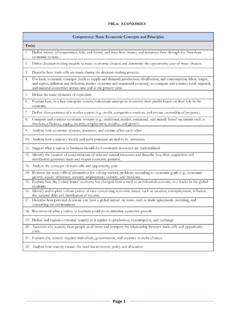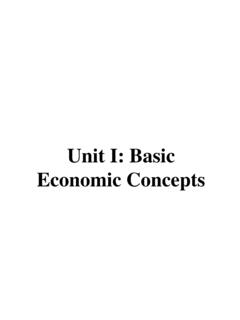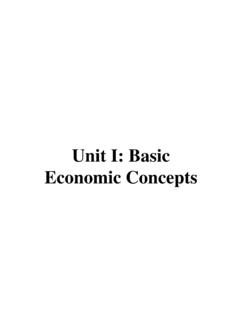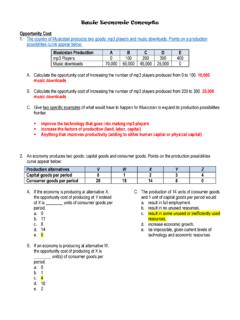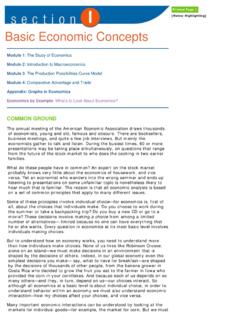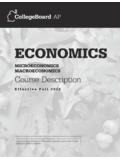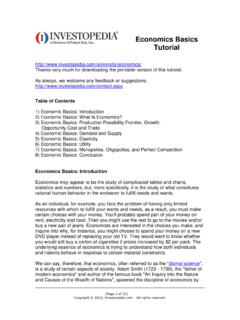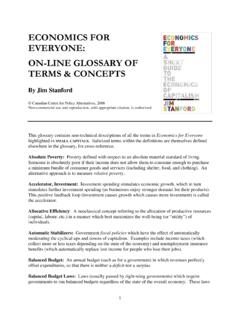Transcription of AP Krugman Section 1 Problem Solutions 1. 2. a.
1 Solutions to Section 1 Problems 29 AP Krugman Section 1 Problem Solutions 1. The four categories of resources are land, labor, capital, and entrepreneurship. Possible examples of resources include the property where the factory is located (land), factory workers (labor), sewing machines (capital), and the design of the assembly line (entrepreneurship). 2. a. One of the opportunity costs of going to college is not being able to take a job. By choosing to go to college, you give up the income you would have earned on the job and the valuable on-the-job experience you would have acquired.
2 Another opportunity cost of going to college is the cost of tuition, books, supplies, and so on. On the other hand, the benefit of going to college is being able to find a better, more highly paid job after graduation in addition to the joy of learning. b. Watching the movie gives you a certain benefit, but allocating your time (a scarce resource) to watching the movie also involves the opportunity cost of not being able to study for the exam. As a result, you will likely get a lower grade on the exam and all that that implies. c. Riding the bus gets you where you need to go more cheaply than, but probably not as conveniently as, driving your car.
3 That is, some of the opportunity costs of taking the bus involve waiting for the bus, having to walk from the bus stop to where you need to go rather than parking right outside the building, and probably a slower journey. If the opportunity cost of your time is high (your time is valuable), these costs may be prohibitive. 3. a. The worse the job market, the lower the opportunity cost of getting a graduate degree. One of the opportunity costs of going to graduate school is not being able to work. But if the job 30 Section 1: basic economic concepts market is bad, the salary you can expect to earn is low or you might be unemployed so the opportunity cost of going to school is also low.
4 B. When the economy is slow, the opportunity cost of people s time is also lower: the wages they could earn by working longer hours are lower than when the economy is booming. As a result, the opportunity cost of spending time doing your own repairs is lower so more people will decide to do their own repairs. c. The opportunity cost of parkland is lower in suburban areas. The price per square foot of land is much higher in urban than in suburban areas. By creating parkland, you therefore give up the opportunity to make much more money in cities than in the suburbs. d. The opportunity cost of time is higher for busy people.
5 Driving long distances to supermarkets takes time that could be spent doing other things. Therefore, busy people are more likely to use a nearby convenience store. 4. a. The positive statements are: workers in Asia .. [are] earning only pennies an hour American workers are more productive American workers are more productive and, as a result, earn higher wages The normative statement is: the government should enact legislation banning imports of low-wage Asian clothing b. It is not. The statement about the productivity of American and Asian workers is about the absolute advantage that American workers have over Asian workers.
6 However, Asian workers may still have a comparative advantage. And if that is the case, then banning imports would result in inefficiency. Solutions to Section 1 Problems 31 c. If America channeled more of its productive resources into producing clothing, it would have to give up producing other goods. As a result, America would be able to consume less of all goods. And this would make some Americans clearly worse off. Therefore, this policy would not be efficient. d. Low-wage Asian workers would also be hurt by this policy. The Asian country would channel its resources away from producing clothing toward producing other goods that it previously imported from America.
7 But since it does not have the comparative advantage in those other goods, the Asian country would be able to consume less of all goods. 5. a. True. This is a positive statement. It has a factual answer; that is, it is either right or wrong. There has been some debate about whether the statement is actually true or false, but in principle there is only one answer. b. False. This is a statement about what we should do, and this statement has no clearly right or wrong answer. Your view will depend on whether you think encouraging more work is a good or a bad idea. c. True. Economics is best at giving positive answers, for instance, answers about what the most efficient way is of achieving a certain aim.
8 The question of how society ought to be organized is mostly decided in the realm of politics. d. False. This is a positive statement. In principle, it has an answer that is either right or wrong. e. False. Some disagreements among economists arise from the fact that in building a model, one economist thinks that a certain abstraction from reality is admissible but another economist may think that that abstraction is not admissible. Some disagreements arise from the fact that economists sometimes disagree about values. 32 Section 1: basic economic concepts 6. A business-cycle expansion is a period of recovery after a recession, and lasts until the next economic downturn.
9 An expansion can occur regardless of any increase in the economy s long-term potential for production. economic growth increases the economy s ability to produce more goods and services over the long term, and can last for several decades. 7. True. With hindsight it is easier to see the important features of the situation that a model should have captured. For predictive purposes, a model needs to anticipate which features of reality are important (and so should be included) and which are unimportant (and so can be ignored). This is why the famed British economist John Maynard Keynes referred to economics as an art as well as a science.
10 8. a. The accompanying diagram shows the production possibilities curve for Atlantis. b. No, Atlantis cannot produce 500 pounds of fish and 800 pounds of potatoes. If it produces 500 pounds of fish, the most potatoes it can produce is 600 pounds. This point would lie outside the production possibilities curve, at point G on the diagram. Solutions to Section 1 Problems 33 c. The opportunity cost of increasing output from 600 to 800 pounds of potatoes is 200 pounds of fish. If Atlantis increases output from 600 to 800 pounds of potatoes, it has to cut fish production from 500 pounds to 300 pounds, that is, by 200 pounds.
